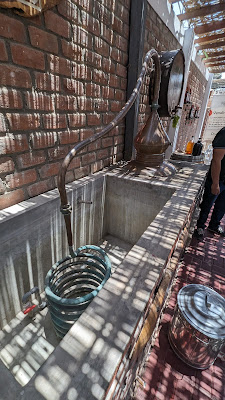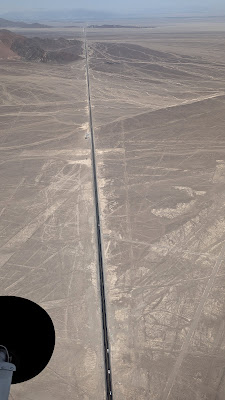Continuing my bus trip through southern Peru after sampling the natural beauty of the area surrounding Paracas I left the coast on Saturday afternoon and started to head inland. The drive through the coastal badlands showed me that it had been a good idea to not make this a bike trip. Even if I had rented a car and had tried to headquarter myself in various Airbnbs along the way (as I had done a year ago in Chile's various wine regions), this would have been a miserable trip. Distances are long, everything is dusty, and there are no secondary roads to speak of. Riding in this area can have only one goal: to cross the continent from the Darien in the north to end up in Ushuaia at the end of the road in Tierra del Fuego. My days to do something like this lie in the past, I'm afraid.
After only about an hour-and-a-half of driving—less than 50 miles—we arrived in (not at) my next destination, the hard-to-conceive Huacachina, close to Ica in the province of Pisco. I had seen pictures of this oasis town, but it was something completely different to leave the barren plains, drive for a couple of miles on a narrow road with busy traffic, and end up in a kettle almost completely surrounded by sand dunes reaching a height of up to 1,650 feet (500 meters)!
In the middle of it all is a small lake, originally fed by artesian springs but, thanks to overuse and the influx of tourists, now supplemented by piped-in water from outside the oasis. The whole place is surreal. The lake is surrounded by the small village of Huacachina, and pretty much every building serves either as a shop, a restaurant, or a hotel. The town has only about 100 residents who call themselves the Guardians of the Oasis; with the help of outside personnel from Ica they run the hospitality industry.
I had booked a "room" at the foot of a steep sand slope that is stopped from infiltrating the compound only by a tall bamboo fence. The Ecocamp Huacachina consists of something like a dozen large tents that are equipped with a couple of beds, a fan, a night table, and pretty much nothing else. There are several shared bathrooms and showers, all very clean. In addition, there's a swimming pool with a few sun loungers and bar tables for breakfast, and a large cochera to park your car or overland truck, whatever your preferred transportation method may be. My tent (the entrance secured with a simple padlock tying together the three zippers) cost a little less than $50 for the night, which sems to be the going rate for non-luxury but decent accommodations here in Peru; hostel beds can be had for as low as $5, but I no longer fancy sharing a room with another eleven people.
 |
One of the "Guardians" simply offered to take my photo after lunch |
Obviously, people come to Huacachina for the sand. For a small fee of about a dollar, collected by a veritable army of wardens, young and old are admitted to the dune area. One can rent surfboards to slide down the slopes, one can pay $20 for a 30-minute dune buggy tour, or one can simply hike. Obviously, that's what I did. Never mind worrying about leaving tracks in what looks like virgin sand—in a short while, the wind will have obliterated any trace that you had been walking here.
The obvious way to get to the top is to follow one of the ridgelines, and it's a bit like walking through deep snow up some mountain. With every step one sinks in, slides back, almost loses one's footing to one side or the other. No, it's not scary—it's just fatiguing as hell! The best way to advance is to use small, steady steps and stop a lot to take in the view. Hip implants are definitely not useful.
Once on top of one of the dunes immediately surrounding the oasis you get a sense of the immensity of the area: Looking toward the southwest you see nothing but dunes, and dunes, and more dunes! I could have sworn I was in the Sahara.
Paradise would have been perfect had it not been for the infernal dune buggies that criss-cross this beautiful landscape with a constant roar of their engines. I would venture that at any given moment you can count at least 30 of them ferrying passengers through what should be a quiet desert. Instead, it sounds like Sebring. At any given time, another 20 or 30 buggies are being loaded with new passengers, and more wailing up the slopes ensues. Another real annoyance is all the plastic trash that blows up and down the slopes. I tried to do my share by picking up a few handfuls of microtrash such as disposable cutlery, bottle tops, and plastic bags, but obviously that won't make any kind of difference. If every hiker were to do this, things would be cleaner—and if such items were banned in the entire oasis area there might be hope.
It was late afternoon, and the sunlight bathed the dunes in a sensuous, velvety light. It was so beautiful. While I was sitting in the sand, which is almost as fine as powdered sugar, the wind would deposit nano-grains in my hair, my ears, my eyes. Now I understand why the bedouins wear those scarves! With the sun starting to slowly descend ever closer toward the horizon I slowly made my way back down and watched the changing nature of the light as well as how the tiny town was preparing for nightfall with street lights coming on and dusk settling on this odd enclave.
Once on top of one of the dunes immediately surrounding the oasis you get a sense of the immensity of the area: Looking toward the southwest you see nothing but dunes, and dunes, and more dunes! I could have sworn I was in the Sahara.
It was late afternoon, and the sunlight bathed the dunes in a sensuous, velvety light. It was so beautiful. While I was sitting in the sand, which is almost as fine as powdered sugar, the wind would deposit nano-grains in my hair, my ears, my eyes. Now I understand why the bedouins wear those scarves! With the sun starting to slowly descend ever closer toward the horizon I slowly made my way back down and watched the changing nature of the light as well as how the tiny town was preparing for nightfall with street lights coming on and dusk settling on this odd enclave.
Back in town, Peruvian tourists were still using the row boats on the lake while others were buying balloons and sugar candy on the lake promenade. Restaurants were busy, a string quartet gave a free concert, and the noise of the buggies had finally ebbed away. I selected what seemed like a fitting restaurant for dinner and later enjoyed a few maracuya sour drinks while working on the blog. I made it back to the camp around 23:30 hrs and had to tell a group of merrymakers that it was time to close down the drinking and let others sleep. From some of the surrounding hotels shrieky laughter emitted by drunken globetrotters continued until the wee hours....
I was awakened by the loud diesel engine of one of the two huge overland trucks that had been parked within the compound's cochera, and soon people were getting up, talking sotto voce but they might have well been shouting. I was reminded of waking up in a tent in a national forest campground on a Sunday morning in New Mexico or Colorado; only the wonderful smell of bacon and coffee was missing. Since my bus wasn't going to leave until around 10:00 a.m., I took things easy and enjoyed my breakfast by the pool while continuing to marvel at those dunes.
 |
| Sunday morning at the oasis .... |
You may not have heard much of Peruvian wine, and I hadn't either. I would assume that the annual output of wine in Peru is simply not big enough to establish an export business such as that of Argentina or Chile. But maybe it is also a question regarding the quality of the wine (although I would think that the archetypal American trophy wife might just fancy it): We tasted five or six different ones, and one was sweeter than the next! Now, the first one was actually pleasant, reminding me of a German icewine; the second one went into the direction of a port and was still palatable; and from there the sweetness just went through the roof! No signs of malbec, carmenère, or cab. Yuk. Not something you'd want to pair with a dinner.
Nietto also produces pisco, and that was really much more fun to taste. Being basically the equivalent to Italy's grappa, pisco is also a by-product of the grape and wine production. Our oh-so-goofy guide needed some volunteers for a pisco challenge, and if I had learned anything during our visit to the Jameson distillery in Dublin with Judy so many years ago, always volunteer when tasting is involved as it will mean extra free drinks!
 |
| The pisco still that's still being used—or so they say |
For lunch I ordered an Andean specialty called carapulcra, a rather unattractive stew based on potatoes, pork, peanut, mirasol peppers, garlic, and various spices— and noodles! As we all know, most stews are not visual showstoppers but will floor you with complex, seemingly impossible flavors. Damn, that stuff was good, so good that I missed most of the butt-and-boob shaking of one of the two dancing "entertainers" that Nietto had called into service!
For some reason, instead of continuing to Nazca we now had to head back to Huacachina to pick up a few more Hopsters. On the way the air conditioning, which had been anemic on the way to the vineyard, went completely AWOL. Some woman from Australia—one of a family of four rather unfit-looking individuals—started to loudly complain that it was too hot, that she had not paid for this non-service, that something needed to be done, now. I think most of us just thought, "Shut up with your First World Problems." Our guide, Christian, had been on the phone all the time, trying to find a solution to the problem, and back in Huacachina (which was even more traffic-clogged than it had been on Saturday) we all had to disembark and then wait for half an hour for a replacement bus.
Finally we were on our way. The drive led us through empty spaces of rocky desert. The road was reduced to two lanes, and often we'd stay behind several trucks lumbering along at 15 mph, with no chance to pass. I was sitting in the first row behind the driver and thus had a great observation post, both in regard to traffic as well as landscape. We left the badlands after a twisty descent down dozens of hairpin curves into the Rio Grande valley in which Palta is located. Finally, some signs of agriculture reappeared.
We were quite some time behind schedule but still made it to the Nazca Lines observation tower maybe 20 minutes before sunset. Christian gave us a brief introduction to the lineas and we all went to the top of the tower. And there we saw them, two designs that from ground level you would never recognize. One of them, the Lizard, was cut in half when the Pan-American Highway, on which we had been traveling since Lima, was built. Now, the entire area between Palta and Nazca is, of course, a UNESCO World Heritage Center that commands protection.
We piled back into the bus and 20 minutes later we reached Nazca, the city. The bus stopped literally nextdoor to my hotel, and another long day on the road came to its conclusion. My room in the Alegra was clean and comfortable, as was the entire hotel with its courtyard with pool and pretty landscaping. Yep, again $47, including a nice breakfast.
Monday was the day of my plane trip over the Nazca Lines. I do not have a "bucket list," but since my early teenage years (or a bit earlier) I had read Erich von Däniken's Chariots of the Gods and similar tomes and become interested in some of his (and others') sometimes rather outlandish theories and explanations of things we don't really understand, still. So, when I went through the planning stage of my current trip it was clear that I was going to have to create an opportunity to see the lines from the air.
I'll spare you all the confusion, waiting, and general wasting of a lot of time on Monday. The important thing is that I did get to fly and that the pilot and the guide were super professional and that the whole excursion was well worth the money. (I paid about $100 for the flight as well as two different airport and security taxes that totalled about $30, with transportation from and back to the hotel included.) We were a group of six passengers plus pilot and guide, and the flight lasted for about 35 or so minutes.
Flying over the lineas is a big business in Nazca, which lives for and by this huge tourist attraction, as evidenced by the incorporation of the various designs into everything from park mosaics to bus shelters to the ceiling in Mom's Café. The small airport is home to at least a dozen companies that operate tours day in, day out. To participate, you need to show your passport, pay the appropriate taxes (in cash, at two different counters), undergo a security check (it's OK to just tell them that you set off the sirens because you have a hip implant), and follow all instructions. (COVID regulations are still [posted, but they may be seen as a historical relic and thus stay on the walls forever.) That's all. They take care of the rest.
Flying over the lineas is a big business in Nazca, which lives for and by this huge tourist attraction, as evidenced by the incorporation of the various designs into everything from park mosaics to bus shelters to the ceiling in Mom's Café. The small airport is home to at least a dozen companies that operate tours day in, day out. To participate, you need to show your passport, pay the appropriate taxes (in cash, at two different counters), undergo a security check (it's OK to just tell them that you set off the sirens because you have a hip implant), and follow all instructions. (COVID regulations are still [posted, but they may be seen as a historical relic and thus stay on the walls forever.) That's all. They take care of the rest.
It was a treat to fly over this area. The designs on the ground do not appear as big as I had imagined them to be (we flew at about 2,500 to 3,000 feet), but once you spotted them they were so clear and visible! Our guide did a great job pointing out the various designs, the pilot would dip the wings to the right or the left, and the guide would give us a 3 – 2 – 1 countdown so we could follow the direction of the wing and pinpoint the exact location. For most of the designs the pilot would go for two approaches so that everyone got a perfect view.
It's a bit crazy that this blog entry covers a mere three days of my life.Sometimes, we're just inundated with impressions that create lasting memories, and then there are those blah times. Right now, things are going pretty much full throttle!

















































































Großartig
ReplyDeleteVery cool! Adding to my bucket list.
ReplyDelete